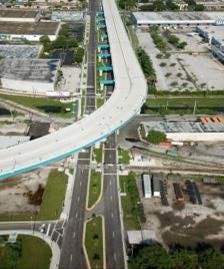Road Project Gives Trucks Direct Access to MIA Cargo Area
On July 15, officials from Miami-Dade County, the Florida Department of Transportation (FDOT) and the city of Doral celebrated the completion of the elevated NW 25th Street Viaduct, a $63 million project that now allows approximately 5,000 cargo trucks daily to travel directly to and from Miami International Airport’s West Cargo Area and avoid local traffic congestion.
“Modernizing our cargo area is critical to maintaining our position as America’s busiest international freight airport and one of the busiest in the world,” said Miami-Dade Aviation Director Emilio T. González. “N.W. 25th Street is the main artery for ground traffic between MIA’s cargo area, the busy warehouse district west of MIA, and Florida’s highway system, so the completion of the viaduct is a major milestone for our airport and ultimately, our local, state and national economy. Congratulations to the FDOT for bringing this important project to fruition.”
The viaduct, or raised bridge, provides a continuous link for cargo traffic traveling to and from MIA above street lights and local traffic on N.W. 25th Street. The viaduct also offers westbound cargo traffic a direct connection to northbound State Road (SR) 826. It now connects with the previously constructed east viaduct, goes over the 826 expressway, and touches down just east of N.W. 82nd Avenue.
The new viaduct now provides a dedicated, expedited and safe ground transport connection for MIA’s valuable cargo business. More than $52 billion in trade came through our airport in 2015, which was 93 percent of all the air trade to Florida and 37 percent of the air and sea trade to Florida. Nationally, MIA handles more than 66 percent of all the perishable imports to the U.S., including nearly 90 percent of all the flowers imported to our country. In total, $2.7 billion worth of perishables came through MIA last year.
The Viaduct Project is among a number of cargo enhancements introduced recently and on the horizon. Last November, MIA became the first airport in the U.S. and only the second in the world to be designated as a pharmaceuticals freight hub by the International Air Transport Association (IATA). MIA was recognized for organizing its pharma logistics providers to undergo IATA’s Pharma Certification Program, which certifies that pharma products are transported in accordance with global best practices.
To attract new business opportunities and better utilize vacant cargo and non-terminal areas, MDAD is in the process of establishing a Foreign Trade Zone (FTZ) Magnet Site on MIA property. Potential site users would activate individual zones or sub-zones that qualify them for deferment of tariffs to stimulate international trade and diversify business activities at the airport. With a projected launch date of early 2017, the MIA FTZ has the potential to generate $7.7 million annually in lease revenue and create an estimated 1,500 jobs at MIA. MDAD this year is also finalizing its Cargo Optimization, Redevelopment and Expansion (CORE) Program, a comprehensive plan to modernize the airport’s existing cargo operation and double its capacity.


